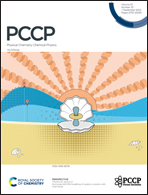Temperature dependence of radiative and non-radiative decay in the luminescence of one-dimensional pyridinium lead halide hybrids†
Abstract
The photoluminescence properties of organic–inorganic pyridinium lead bromide [(pyH)PbBr3] and iodide [(pyH)PbI3] compounds were investigated as a function of temperature. The inorganic substructure consists of face-sharing chains of PbX6 octahedra. Diffuse reflectance spectra of the compounds show low energy absorption features consistent with charge transfer transitions from the PbX3 chains to the pyridinium cations. Both compounds display extremely weak luminescence at room temperature that becomes strongly enhanced upon cooling to 77 K. Broad, featureless low energy emission (λem > 600 nm) in both compounds have large Stokes shifts [1.1 eV for (pyH)PbBr3 and 0.46 eV for (pyH)PbI3] and are assigned to transitions from self-trapped excitons on the inorganic chains whereas emission at higher energy in (pyH)PbBr3 (λem = 450 nm) is assigned to luminescence from a free exciton state. Analysis of data from temperature-dependent luminescence intensity measurements gives activation energies (Ea) for non-radiative decay of the self-trapped excitons in (pyH)PbBr3 and (pyH)PbI3, (Ea = 0.077 eV and 0.103 eV, respectively) and for the free exciton in (pyH)PbBr3 (Ea = 0.010 eV). Analysis of temperature dependent luminescence lifetime data indicates another non-radiative decay process in (pyH)PbI3 at higher temperatures (Ea = 0.17 eV). A large increase in the luminescence lifetime of (pyH)PbI3 below 80 K is consistent with thermalization between triplet sublevels. Analysis of the luminescence power dependence for (pyH)PbI3 shows superlinear response suggestive of quenching by static traps.



 Please wait while we load your content...
Please wait while we load your content...